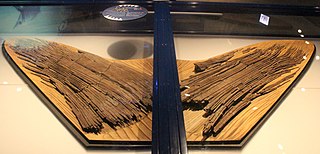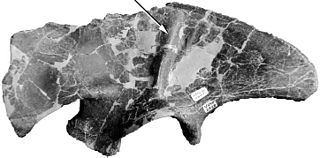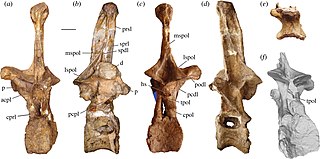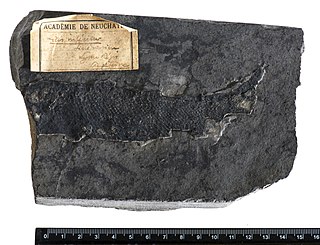
Torvosaurus is a genus of large megalosaurine theropod dinosaur that lived approximately 165 to 148 million years ago during the Callovian to Tithonian ages of the late Middle and Late Jurassic period in what is now Colorado, Portugal, Germany, and possibly England, Spain, Tanzania, and Uruguay. It contains two currently recognized species, Torvosaurus tanneri and Torvosaurus gurneyi, plus a third unnamed species from Germany.

Dryosaurus is a genus of an ornithopod dinosaur that lived in the Late Jurassic period. It was an iguanodont. Fossils have been found in the western United States and were first discovered in the late 19th century. Valdosaurus canaliculatus and Dysalotosaurus lettowvorbecki were both formerly considered to represent species of Dryosaurus.

Leedsichthys is an extinct genus of pachycormid fish that lived in the oceans of the Middle to Late Jurassic. It is the largest ray-finned fish, and amongst the largest fish known to have ever existed.

Saurophaganax is a genus of large allosauroid dinosaur from the Morrison Formation of Late Jurassic Oklahoma, United States. Some paleontologists consider it to be a junior synonym and species of Allosaurus. Saurophaganax represents a very large Morrison allosauroid characterized by horizontal laminae at the bases of the dorsal neural spines above the transverse processes, and "meat-chopper" chevrons. It was the largest terrestrial carnivore of North America during the Late Jurassic, reaching 10.5 metres (34 ft) in length and 2.7–3.8 metric tons in body mass.

Gastonia is a genus of herbivorous ankylosaurian dinosaur from the Early Cretaceous of North America, around 139 to 134.6 million years ago. It is often considered a nodosaurid closely related to Polacanthus. Gastonia has a sacral shield and large shoulder spikes.

Stokesosaurus is a genus of small, carnivorous early tyrannosauroid theropod dinosaurs from the late Jurassic period of Utah, United States and Guimarota, Portugal.

Marshosaurus is a genus of medium-sized carnivorous theropod dinosaur, belonging to the family Piatnitzkysauridae, from the Late Jurassic Morrison Formation of Utah and possibly Colorado.

Leptolepis is an extinct genus of stem-teleost fish that lived in what is now Europe and North of Africa during the Jurassic period.

Chinlea is an extinct genus of late Triassic Mawsoniid coelacanth fish found in and named after the Chinle Formation that crops out in the southwestern states of Arizona and New Mexico. The word “Chinle” comes from the Navajo word meaning "flowing out", referencing the location where water flows out of the Canyon de Chelly. They were also possibly found in the Dockum Group.

Amphicoelias is a genus of herbivorous sauropod dinosaur that lived approximately 150 million years ago during the Tithonian of what is now Colorado, United States. Amphicoelias was moderately sized at about 18 metres (59 ft) in length and 15 metric tons in body mass, shorter than its close relative Diplodocus. Its hindlimbs were very long and thin, and its forelimbs were proportionally longer than in relatives.

Eutretauranosuchus is an extinct genus of goniopholidid crocodyliform. E. delfsi is the only known species within the genus.
Asarotus is an extinct genus of prehistoric marine ray-finned fish from the Niobrara Formation of Nebraska, during the Campanian. The type species, A. arcanus is only known from poorly preserved single specimen, which makes hard to classify existing orders of Cretaceous actinopterygians. It is thus classified as the only member of its family Asarotidae and order Asarotiformes. Some authorities consider it a late-surviving member of the "palaeonisciform" fishes.
Moenkopia is an extinct genus of prehistoric sarcopterygians from the Coelacanthidae found in the Middle Triassic Moenkopi Formation of Arizona. The type, and only species, M. wellesi, was named in 1961 in honour of Samuel Paul Welles. It is only known from the holotype, UMCP 36193, a partial skull consisting only of the basisphenoid that was collected in 1939 or 1940 by Samuel Welles and briefly noted on by him in 1947, and other assorted specimens found before 2005 in the Radar Mesa by S. J. Nesbitt, W. G. Parker and R. B. Irmis.

Cosmolepis is an extinct genus of prehistoric marine ray-finned fish that lived during the Early Jurassic epoch. It contains a single species, C. ornatus from the Blue Lias in what is now England. It is the only member of the family Cosmolepididae.
Occithrissops is an extinct genus of ray-finned fish of the Jurassic, described from Sundance Formation. The genus name of Occithrissops refers to the occidental occurrence of the genus and its relationship to Thrissops.

Morrolepis is an extinct genus of prehistoric coccolepidid "palaeoniscoid" ray-finned fish that lived during the Late Jurassic and earliest Cretaceous epochs in Europe, Asia and North America.

Uteodon is a genus of herbivorous iguanodontian dinosaur. It is a basal iguanodontian which lived during the late Jurassic period in what is now Uintah County, Utah. It is known from the middle of the Brushy Basin Member, Morrison Formation. The genus was named by Andrew T. McDonald in 2011 and the type species is U. aphanoecetes.

Redfieldius is an extinct genus of freshwater ray-finned fish that inhabited eastern North America during the Early Jurassic period. It contains a single species, R. gracilis, known from the Hettangian to the Sinemurian of the northeastern United States. It is the type genus and was the last surviving member of the order Redfieldiiformes, which was widespread and diverse throughout the preceding Triassic period. It is notable for representing possibly the first fossil bony fish collected from North America, with a specimen from Middletown collected in 1816 by Benjamin Silliman.
Tanaocrossus is an extinct genus of primitive freshwater ray-finned fish that inhabited southwestern and eastern North America during the Late Triassic period. It contains a single known species, T. kalliokoskii, known from the United States, with indeterminate species also known.

Ardetosaurus is an extinct genus of diplodocid sauropod dinosaurs from the Late Jurassic (Kimmeridgian) Morrison Formation of northern Wyoming, United States. The genus contains a single species, Ardetosaurus viator. It was first described in 2024 on the basis of a partial articulated skeleton, including vertebrae from the neck, back, and tail, hip bones, and part of the left hindlimb. The genus is a member of the Diplodocinae, a subfamily of large long-necked dinosaurs with whiplike tails. Ardetosaurus represents one of many distinct sauropod taxa that coexisted in this formation.





















